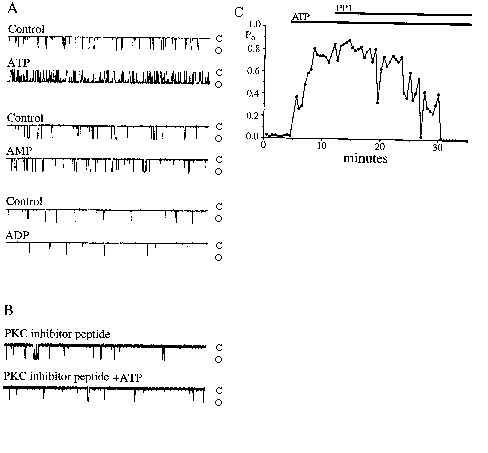Cell and Molecular Neurobiology - Biology 304
Homework Assignments
Assignment #1 -- Due September 24, 1998
1. Effect of changing potassium concentration of the action potential. What effect does decreasing external K+ have on the peak of the action potential, the after-hyperpolarization, the resting membrane potential, and the maximal rate of rise of the action potential? What happens to threshold? Explain the observed changes in terms of the potassium equilibrium potential and/or the driving force on potassium. Use sod-1.hh file in NeuroSim.
2. Refractory period. Determine the duration of the absolute refractory period of the action potentials generated using file refr-cl.hh (file is in the samples folder of Neur oSim HH). What property of the channel controls the duration of the refractory period? Keep the stimulus strength constant? Use illustrations from NeuroSim if necessary. What happens to the absolute refractory period when you increase the strength of the second pulse?
3. Channels. Using file prob3.nm in NeuroSim module Neuron identify the four different channels that contribute to the bursting pattern of the neuron. Explain which part of the burst cycle each channel affects. For example, what channel is responsible for producing the rising phase of each action potential during a burst?
Homework #2
Due Thursday November 12, 1998
1. IPSP Reversal Potential
Determine the reversal potential of the inhibitory connection from neuron 1 to neuron 2 and explain why the amplitude of the IPSP is zero at the reversal potential. To determine the reversal potential you will need to change the resting membrane potential of neuron 2. Use NeuroSim Network File syn-inh.
2. Synaptic Integration
Open NeuroSim Network file - hwork2.ntw. The initial configuration has amp of Pulse 1 set to 40 (target = neuron 5) and the amp of Pulse 2 set to zero. Make sure these parameters are correct. Start simulation. Note the response that stimulating neuron 5 has on neuron 1. Now set amp of Pulse 2 to 30, target neuron of Pulse 2 to 6 and run simulation again. How has the response induced in neuron 1 by stimulating neuron 5 changed? Why? Finally, set target neuron of Pulse 2 to 7 and run simulation. What effect has the synaptic input from neuron 7 had on the response produced in neuron 1 by stimulating neuron 5? Why does the same strength synaptic input (number of action potentials in neuron 6 and 7) have a different effect on the response in neuron 1 to stimulating neuron 5? Note that neuron 1 represents the soma of a neuron, and neurons 2, 3 and 4 comprise its non-spiking (passive membrane) dendrite.
3. Functional Organization of Cotransmission Systems: Lessons from Small Nervous Systems. Invertebrate Neuroscience 1:105-112 (1995).
What are the implications of cotransmission of neuromodulatory peptides with respect to synaptic integration and the communication between neurons?
Homework #3
Due Tuesday December 8, 1998
1. What function do G-proteins serve in second messenger systems and how are they regulated?
2. Why does the reciprocal inhibitory network simulated in NeuroSim Network file recip-3 oscillate?
3. What does the figure below suggest about the mechanism that regulates activity (gating) of nonspecific cation (e.g. calcium, barium etc.) channels in the bag cell neurons of Aplysia. Note that the experiments illustrated in the figure were performed on inside-out patches excised from the cell bodies of single bag cell neurons.
Abbreviations: ATP - adenosine triphosphate, AMP - adenosine monophosphate, ADP - adenosine diphosphate, PKC inhibitor - peptide that inhibits the action of protein kinase C, PP1 - protein phosphatase, C - channel in closed state, O - channel in open state.

Possible Independent Laboratory Projects
1. How does external K+ concentration affect the resting membrane potential of leech neurons? What affect does ouabain have on the resting membrane potential? What effect does intracellular inject of NaAC have on the resting membrane potential?
2. How is the amplitude and duration of action potetials in Retzius cells affected by varying the external concentration of Na+, Ca++ and K+?
3. What effect do TEA, procaine and temperature have on action potenitals in Retzius cells?
4. Analysis of the electrical synpatic connection between Retzius cells. Demonstration that the synaptic connection between the Retzius cells is electrica and not chemical. What is the coupling coefficient of the electrical synapse? Can the coupling coefficient be modified?
5. Map the receptive fields of mechanosensory neurons.
6. Neuromodulation of local bending. What effect does stimulating the Leydig cell have on motor activity (recorded extracellularly in a peripheral nerve) elicited by stimulation of mechanosensory neurons?
7. Analysis of the chemical synaptic connection from P cells to AP cells (or from DP nerve to Retzius cells). Is the connection monosynaptic? Is the connection mediated by the release of glutamate? Does the connection show synaptic facilitation or depression?
8. Compare the connection from DP nerves to Retzius cells in non-sex and sex ganglia.
Bryn Mawr Biology Department Homepage
Biology Seminars
NONE YET!!!
Park Science Center, Biology Building, Room 229
Southeast corner of Roberts and New Gulph Roads
Following the seminar, refreshments will be served in Room 227